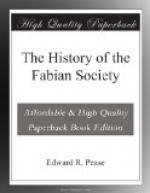In 1912 Clifford Allen of Cambridge formed the University Socialist Federation, which was in fact a Federation of Fabian Societies though not nominally confined to them. Mr. Allen, an eloquent speaker and admirable organiser, with most of the virtues and some of the defects of the successful propagandist, planned the foundations of the Federation on broad lines. It started a sumptuous quarterly, “The University Socialist,” the contents of which by no means equalled the excellence of the print and paper. It did not survive the second number. The Federation has held several conferences, mostly at Barrow House—of which later—and issued various documents. Its object is to encourage University Socialism and to found organisations in every University. It still exists, but whether it will survive the period of depression which has coincided with the war remains to be seen.
Lastly, amongst the organs of Fabian activity come the London Groups. In the years of rapid growth that followed the publication of “Fabian Essays” the London Groups maintained a fairly genuine existence. London was teeming with political lectures, and in the decade 1889-1899 its Government was revolutionised by the County Councils Act of 1888, the Local Government Act of 1894, and the London Government Act of 1899 which established the Metropolitan Boroughs. Socialism, too, was a novelty, and the few who knew about it were in request.
Anyway even with the small membership of those days, the London Groups managed to persist, and “Fabian News” is full of reports of conferences of Group Secretaries and accounts of Group activities. In the trough of depression between the South African War and the Liberal victory of 1906 all this disappeared and the Group system scarcely existed even on paper.
With the expansion which began in 1906 the Groups revived. New members were hungry for lectures: many of them desired more opportunities to talk than the Society meetings afforded. All believed in or hoped for Mr. Wells’ myriad membership. He himself was glad to address drawing-room meetings, and the other leaders did the same. Moreover the Society was conducting a series of “Suburban Lectures” by paid lecturers, in more or less middle-class residential areas of the Home Counties. Lectures to the Leisured Classes, a polite term for the idle rich, were arranged with considerable success in the West End, and other lectures, meetings, and social gatherings were incessant.




